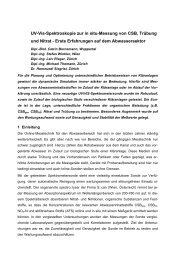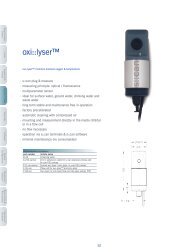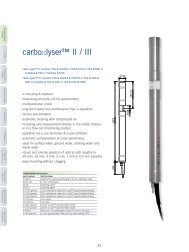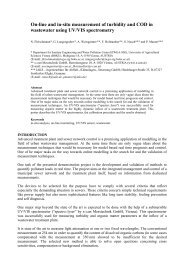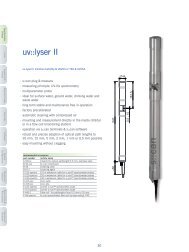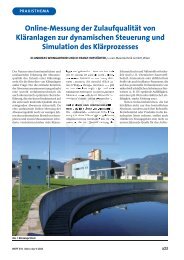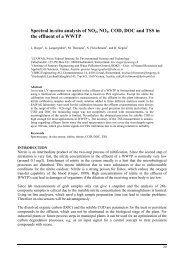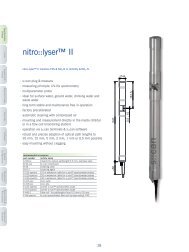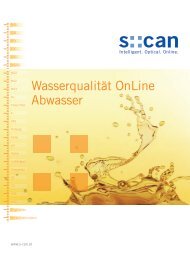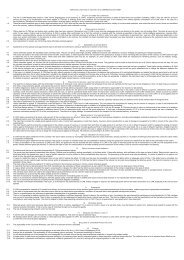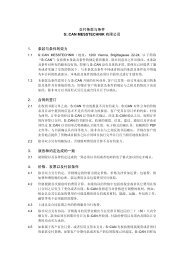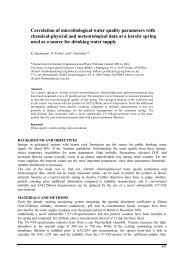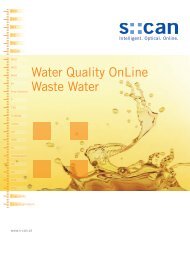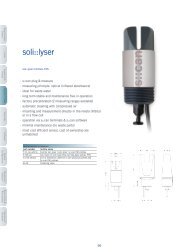Water Quality OnLine Drinking Water - S-can
Water Quality OnLine Drinking Water - S-can
Water Quality OnLine Drinking Water - S-can
Create successful ePaper yourself
Turn your PDF publications into a flip-book with our unique Google optimized e-Paper software.
The s::<strong>can</strong> solution<br />
s::<strong>can</strong> spectral instruments capture the major proportion of organic<br />
carbon compounds (because they are chemo-physically similar to<br />
UV oxidation in a TOC analyser), which as a general rule correlates<br />
excellently with the reference measurements. Recovery is estimated<br />
to be about 80% in domestic waste water. The correlation with<br />
other oxidative methods for TOC analysis is usually also good but,<br />
like all methods, it also has certain limits. Our experts <strong>can</strong> now almost<br />
always say from experience how good the expected correlation<br />
will be and help you with optimising the results.<br />
The comparison between laboratory COD or laboratory TOC and<br />
spectrometrically determined values should always be better than<br />
90% depending on the distribution of your reference samples. If<br />
that does not work out or is not satisfactory straight away, please<br />
contact s::<strong>can</strong> Support (email: support@s-<strong>can</strong>.at).<br />
For many applications the distinction between total COD and dissolved<br />
COD, or between TOC and DOC is of major importance. This<br />
distinction is based on a physically consistent description of the<br />
solids by a spectral algorithm that has now been proven in practice<br />
thousands of times. (See diagram on the next page).<br />
In addition here comes another great advantage of spectrometry:<br />
Not only <strong>can</strong> one quantify any change of the concentration of total<br />
organic compounds, expressed by COD or TOC, but it is also possible<br />
to identify several differentiated groups of organics or even<br />
detect individual organic substances that cause this change. It is<br />
even possible to distinguish between “normal” and “abnormal”<br />
(mostly undesirable) organic composition in “event detection systems”.<br />
The s::<strong>can</strong> spectrometer probe is now accepted by public<br />
authorities in many countries as a substitute measurement for COD<br />
or TOC, and this strong trend is continuing.<br />
Spectral BOD as provided by s::<strong>can</strong> has nothing to do with the<br />
widely used simple correlation of BOD to UV254 that is used by<br />
other manufacturers but which seldom works reliably.<br />
In principle it is not the respiration of the bacteria that is tracked -<br />
the standard measurement - but it is the easily digestible fraction<br />
of the organic compounds that is measured directly. To this end<br />
spectral algorithms were developed for various waters from thousands<br />
of samples, and these are based on the spectral integral<br />
of light absorption of biologically easily accessible chromophorous<br />
carbon compounds (e.g. proteins, acids etc.) in the wavelength<br />
range as pictured in the diagram on the next page.<br />
It is always recommended that the BOD (as opposed to other spectral<br />
parameters) be calibrated on initialisation of a measuring station<br />
by comparison with a reference method.<br />
The comparison between laboratory BOD and spectrally-determined<br />
online values should be better than 85%. If that is not sufficient<br />
or does not work straight away, just contact s::<strong>can</strong> Support<br />
and together we will achieve a still better correlation by supporting<br />
you with the reference measurements and/or conduct a calibration<br />
specifically for you.<br />
Conventional solutions<br />
The traditional measurement of COD is conducted after pulping the<br />
sample with oxidants of varying strength (and varying harm to the<br />
environment) such as dichromate (about 90% recovery efficiency<br />
in domestic waste water) or manganese III (about 80% recovery<br />
efficiency in domestic waste water). In the attempt to come as<br />
close as possible to the normative standards, laboratory methods<br />
were transferred to field analysers and hardly changed. As these<br />
methods are not really practical in process and field applications,<br />
these analysers are as a rule expensive to buy and operate, complicated,<br />
unreliable and harmful to the environment, and often still<br />
do not conform to the legal standards. The quality of measurement<br />
actually achieved is then mostly well below the given specification<br />
since very few users have the time to invest in these instruments to<br />
keep them operating reliably. But even if these instruments worked<br />
perfectly, their availability and the accuracy achieved are still well<br />
below that of spectral probes since it is not easy to gain control of<br />
the incidental and systematic errors that occur because of their<br />
complexity.<br />
It is not without reason that the replacement of COD cabinet analysers<br />
is one of s::<strong>can</strong>’s major areas of business.<br />
The disadvantages of TOC analysers occur in a similar area. In addition,<br />
depending on the method used, there is only ever a certain<br />
proportion of the organic carbon compounds that is oxidised and,<br />
as a result of the method, that fraction may well also detected by<br />
the spectral probe as is the case with UV pulping which is popular<br />
due to being considered comparatively environmentally friendly.<br />
Although BOD is a very interesting parameter, in particular for the<br />
modelling and layout of waste water treatment plants, it is difficult<br />
to sample, prepare and also to analyse. The main reason is clear.<br />
After all one is working here with living organisms that may behave<br />
quite differently depending on the water quality and experimental<br />
conditions thus a lot of scattering is introduced. BOD is normally<br />
measured by detecting the respiration of bacteria via oxygen content<br />
or indirectly via the gas pressure. Among other things, measurement<br />
in the low concentration range or in the presence of inhibitors<br />
regularly causes problems.<br />
BOD cabinet analysers in particular do not reflect BOD according to<br />
the standard and they must therefore first be compared themselves<br />
with the “true” BOD method and calibrated accordingly. The maintenance<br />
effort may be considerable, which is why BOD is rarely<br />
measured online with any enthusiasm.<br />
11<br />
© s::<strong>can</strong> Messtechnik GmbH<br />
COD<br />
COD<br />
dissolved<br />
TOC<br />
BOD



